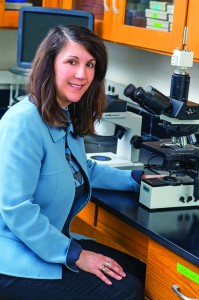The headlines are never far away. A young actress or musician enters a rehabilitation center to confront problems with drugs or alcohol. A singer or actor is discovered, lifeless — having lost the battle with addiction.
Addiction doesn’t discriminate. It strikes men, women, young, old, rich and poor. While national statistics say 40 million Americans over age 12 struggle with alcohol and drug addiction, very little is known about how the disease works.
On April 2, 2013, President Barack Obama announced the BRAIN Initiative (Brain Research through Advancing Innovative Neurotechnologies) — a new research effort to revolutionize our understanding of the human mind and uncover new ways to treat, prevent and cure brain disorders like drug addiction.
It’s this mystery that neuroscience researchers in UNC’s department of psychology are trying to solve. By looking inside the brain and testing clinical interventions, they’re learning how drugs and alcohol affect the brain and are designing strategies to help break the cycle of addiction.
The science behind addiction
Before clinical work begins, researchers must understand the physical changes addiction prompts in the brain. For example, professor and behavioral neuroscience program director Todd Thiele studies the interplay between protein-like molecules and binge drinking — consuming five or more drinks for men and four or more for women within two hours. His goal: seeing how binge drinking morphs the brain, igniting dependence.
“When we drink alcohol, there are changes in the systems of the brain,” Thiele said. “They’re transient changes after one episode, but after more drinking, those changes become rigid and long-lasting.”
Thiele’s team measures the magnitude of such changes in laboratory rodents.
Researchers also study the effects of the release of a neurochemical called corticotropin-releasing factor. Brain analyses, Thiele said, show increased CRF levels. The neurochemical plays a direct role in encouraging binge drinking behavior, and lasting increases in CRF activity following a history of binge drinking may increase the risk of alcohol dependence.
Ultimately, Thiele said, understanding CRF activity could help identify pharmaceutical targets that could prevent binge drinking.

Professor Regina Carelli and colleagues are tackling the complex problem of drug and alcohol addiction. (photo by Steve Exum)
Regina Carelli, Stephen B. Baxter Distinguished Professor and psychology department associate chair, also uses animal models to study how drugs impact the brain and behavior. Carelli serves on the National Advisory Council on Drug Abuse.
Her team uses electrochemistry to monitor dopamine activity. Dopamine is a neurotransmitter in the brain’s reward and pleasure centers. Carelli’s work shows that dopamine release occurs in response to drug cues, such as when an addict sees drug paraphernalia. While such cues often result in craving and relapse, Carelli has recently shown that prior experience with cocaine — even in relatively small amounts — can also profoundly alter normal learning. Although laboratory rodents can form simple associations, like learning that a tone signals food, their ability to form more complex associations is greatly impaired.
“This impairment in learning that occurs simply as a consequence of prior cocaine exposure may be profound for some people,” she said. Such subtle deficits in learning may prohibit addicts from selecting behaviors that will maximize adaptive long-term goals over their short-term desire to take drugs.
“These findings provide novel insight into why addiction remains a chronically relapsing disorder despite repeated attempts at sobriety,” she added.
Additionally, substance use can negatively affect the immune system. Kenan Distinguished Professor and Psychology Department Chair Donald Lysle investigates how opiates — specifically heroin — impact the brain and the immune system.
Examining the brain-immune system link highlights how drug abuse not only leads to addiction but also has a major impact on health and disease resistance.
“My focus is mapping how drugs of abuse alter neuro-circuitry and neuro-physiology to induce the brain to signal the immune system,” he said. “The idea is to develop — in concert with other strategies — addiction treatments that also could reverse or block the negative health consequences of substance abuse.”
Lysle’s early research showed that a single injection of heroin can produce a 90-percent reduction of immune competent cells — those responsible for normal immune responses. His work reveals a complex relationship between the brain and the immune system. In fact, he shows that the immune system also plays a role in controlling aspects of brain function and that the immune system is intimately involved in many of the responses we see in drug addiction.
“By studying the effects of abused substances on the brain and the immune system, we will be better able to develop strategies that block the health consequences and the addictive properties of these drugs,” he said.
The clinical approach
UNC’s neuroscience efforts also extend beyond the lab. Several faculty are merging scientific research with clinical activities, designing neuroscience-based methods and interventions to treat addictions.
For example, associate professor Stacey Daughters uses advanced diagnostic imaging strategies to monitor how the addicted brain responds to stress, particularly among human cocaine users.
“We can look at the neural indicators of distress tolerance,” Daughters said. Distress tolerance refers to a person’s inability to tolerate negative emotional states, such as feelings of irritability and anxiety that often result in relapse of drug use in addicts.
The theory behind Daughters’ study is that individuals with poor distress tolerance have lower functional levels in the brain areas that control decision-making and goal-directed behavior. And, the inability to manage stress can lead to relapses in substance use.
But is bolstering tolerance to avoid treatment setbacks possible? Daughters’ team is using web-based and smartphone technology to find out. Treatment program participants receive frequent text messages, reminding them of positive behaviors, their goals and ways to reach them.
Analysis continues, but initial results are positive. Smartphone participants are less likely to relapse and are more likely to stick with treatment. Ultimately, she hopes her research can be used to train counselors in the best treatment-delivery methods.
But addiction is notoriously difficult to treat and relapse is common. That is why psychology professor and Center for Developmental Science Director Andrea Hussong is studying the factors that lead up to addiction. By understanding these factors, better programs can be designed to prevent addiction, especially in those who are most vulnerable. The work of Hussong and psychology professors Patrick Curran and Dan Bauer, shows that on average children of alcoholics have greater emotional and behavioral problems than their peers by age 2 and that those problems persist into adulthood, especially for children whose alcoholic parents also have depression. These emotional and behavioral problems, in turn, are linked to risk for addictions beginning in adolescence.
Hussong and her colleagues are trying to prevent these problems from arising. By working with mothers who are in residential treatment for addictions and their pre-school aged children, this research team is working one-on-one with families to help their children succeed.
“Overall, UNC’s psychology faculty are making significant headway in demystifying the cloud of addiction, and shedding needed light on the neurobiology of this chronically relapsing disorder,” Carelli said.
***
Sidebar: Budding Neuroscientists
Carolina undergraduates know all about using their brains to earn top honors. But, in recent years, they’ve become increasingly interested in just how and why the brain works the way it does.
Such curiosity has blossomed into a groundswell fascination among students clamoring to learn more about neuroscience, the study of the mysterious inner-workings of the brain. The shared attraction has been so strong that it’s changed the way students approach the topic — and, it could change how the University teaches it, as well.
In 2009, a few students launched the Carolina Neuroscience Club (CNC) — a campuswide interest group that provides an extracurricular opportunity to delve into the most recent neuroscience discoveries. The group now boasts an overall membership of more than 200 students.
“Neuroscience is such a growing field,” said CNC member Marie Clements, a senior majoring in psychology and biology. “There are new discoveries being made every day. So, there’s a good chance that students will learn something they didn’t already know at these meetings.”
Increased interest in neuroscience across campus reflects a growing intrigue about the brain, said CNC faculty adviser Kelly Giovanello, associate professor of psychology. Having club members from both science and non-science majors plays directly into the interdisciplinary evolution of both research and clinical neuroscience.
Students have requested that faculty design a neuroscience minor. The minor is in the proposal phase right now. Regardless of the outcome, the students involved deserve credit for transforming the study of neuroscience at UNC, Giovanello said.
“It’s really been a grassroots movement by the students in terms of their desire to start a neuroscience academic concentration,” she said.
[ Stories by Whitney L.J. Howell]

